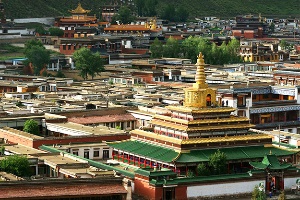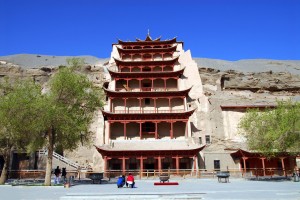Gansu Travel Guide
 The Gansu tourist map
The Gansu tourist map
Gansu, a fortress on the Silk Road, is a magical place full of history and natural beauty. Let us explore the traces of the Silk Road with the sound of camel bells and feel the prosperity of the ancient trade routes.
Welome to Gansu, you can visit the Mogao Grottoes and enjoy the splendor of the thousand-year grottoes art. You can wander through Jiayuguan Pass, hear the echoes of history, and feel the grandeur of the Great Wall. Here, you can climb the Qilian Mountains and overlook the rolling hills, walk-in colorful Danxia in Zhangye, feel the uncanny workmanship of nature, wander around the Dunhuang Yadan landform, and explore the mysterious beauty of geological wonders......
Gansu is not only a vast territory and abundant resources, but also a place of multi-culture integration, Tibetan, Hui, Han, and other ethnic groups live in harmony, writing a colorful chapter on this land.
Our Gnasu Travel Guide can provide useful information for your travel, It's time to start a wonderful trip to Gansu! I'm sure you're looking forward to this trip. Let's embark on a journey to explore the beauty of Gansu, experience its unique charm, and leave your memories of Gansu!
Feature
Chinese: 甘肃 Gansu Area: 425,900 square kilometers
Time Zone: UTC+ 8 Population(2013): About 26,370,000
Location: Northwest China Climate:Temperate continental climate, plateau mountain climate, temperate monsoon
climate, subtropical monsoon climate
Post Code: 730000-747000 Administration: Non-autonomous region
Area Code: (+86) 0930-0939 Annual Rainfall: 300-860 mm
Location of Gansu Province
Gansu Province is located in the northwest of China. It borders the Inner Mongolia Autonomous Region and Ningxia Hui Autonomous Region to the east, Qinghai and Sichuan provinces to the south, Xinjiang Uygur Autonomous Region to the west, and Xinjiang and Inner Mongolia to the north. With a total area of 425,900 square kilometers, accounting for 4.8% of the country’s total area, it is the seventh-largest province in China.
The terrain of Gansu Province is complex and diverse, mainly composed of mountains, hills, and basins. Among them, the Qilian Mountains, Lanzhou Basin, Loess Plateau, the southern foothills of the Qilian Mountains, Hexi Corridor, Alashan Basin, and other unique geomorphological forms constitute the unique geographical features of Gansu.

There are many famous mountains and rivers in Gansu Province. The most famous mountains include the Qilian Mountains and the Qinling Mountains. Located in western Gansu Province, the Qilian Mountains are an important mountain range and a natural barrier in China. The Qinling Mountains are one of the famous mountains in China. Located in the south of Gansu Province, it is the watershed of China. The southern foot of the Qinling Mountains is the Yangtze River basin, and the northern foot is the Yellow River basin.

The famous rivers in Gansu Province are the Yellow River, Heihe River, and Shule River. The Yellow River, the mother river of China and the second largest river in China flows through the southern part of Gansu Province and is the main water source for the province. The Heihe River is an important tributary of Gansu Province. It flows through the western part of the province and is another major water source for Gansu. Shule River is a significant river in Gansu Province. It originates in the Qilian Mountains and flows through western Gansu Province. Shule River is rich in water and plays an important role in local agricultural irrigation and ecological environment. At the same time, the Shule River is also an important source of water for local people and plays an important social and economic role.

Gansu Travel Resources
Gansu, located in the northwest of China, is one of the significant nodes of the ancient Silk Road and has an important strategic position and economic significance. Since ancient times, Gansu has been an important channel connecting China with Central Asia, the Middle East, and Europe. The North and West of the Silk Road meet here, making Gansu a crucial hub for exchanges between Eastern and Western civilizations.The northwest of Gansu has a dry climate and little rain, which has formed natural scenery such as Dunhuang Ancient City, Mogao Grottoes, and Yumenguan ruins. The southeast is warm and rainy, with Qinghai Lake, Maiji Mountain, Chaka Salt Lake, and other unique natural landscapes. Make Gansu a paradise for travel lovers.
 The Jiayuguan Pass
The Jiayuguan Pass
Northwest Gansu is famous for its historical relics. The famous cites include Jiuquan (酒泉), Jiayuguan (嘉峪关), Zhangye (张掖), Dunhuang (敦煌), Yumen (玉门), Guazhou (瓜州), etc. The scenery here has been through the ages. One of the most famous attractions here is the Mogao Grottoes in Dunhuang, which houses a vast collection of valuable Buddhist art and exhibits the grandeur of ancient artwork. Kongtong Ancient City shows the prosperity of the ancient Silk Road, making people feel the thick history. Jiuquan Crescent Moon Spring, Zhangye Danxia landform and other unique natural landscapes show the extraordinary workmanship of nature, which is breathtaking.
 The Yellow River Mother Sculpture
The Yellow River Mother Sculpture
If the northwest of Gansu is the footprint of history, then the southeast is the precipitation of culture. Cites like the Lanzhou (兰州), Tianshui (天水), Qingyang (庆阳), Pingliang (平凉), Gannan Tibetan Autonomous Prefecture (甘南藏族自治州), Linxia Hui Autonomous Prefecture (临夏回族自治州), etc. Most cities in the southeast Gansu are significant areas where Chinese culture originated and developed. When you come here, you can feel the Tibetan customs of the Gannan Tibetan area, the Hui culture of Linxia Hui Autonomous Prefecture, etc. Showing the local customs and traditional customs of different ethnic groups, so that you can appreciate the charm of multi-culture.
Gansu is a place full of charm, whether it’s natural scenery, history, culture, folk customs, or regional characteristics that let people linger. Welcome to Gansu, feel the charm here, experience the customs here, and leave a good memory. Gansu is a province waiting to be discovered and explored. Plan your trip to Gansu today and embark on a journey of discovery and adventure in this hidden gem of northwestern China.
Top Gansu Tourist Attractions
Gansuis a region rich in history, culture, and natural beauty. With a diverse range of attractions, Gansu offers visitors a unique travel experience that combines ancient history, stunning landscapes, and vibrant local traditions. Here are some of the top tourist attractions in Gansu that you should not miss when visiting this fascinating province.
 The Dunhuang Mogao Grottoes
The Dunhuang Mogao Grottoes
One of the most famous landmarks in Gansu is the Mogao Grottoes, also known as the Thousand Buddha Grottoes. Located in Dunhuang, the Mogao Grottoes are a UNESCO World Heritage Site and contain a vast collection of Buddhist art spanning over a thousand years. The intricate murals and sculptures in the caves provide a glimpse into the rich cultural heritage of ancient China and are a must-see for any history or art enthusiast.
 The Jiayuguan
The Jiayuguan
Another must-see in Gansu is Jiayuguan Pass, often referred to as “the first Pass under heaven (天下第一关).” This ancient fortress was once an important military stronghold on the Silk Road, with its majestic masonry and stonework still standing through the storms. A museum inside the Jiayugaun, displays a wealth of historical artifacts, allowing people to appreciate the ancient border customs. The scenery outside the Pass is beautiful, with the desert and Gobi contrasting with the majestic mountains and rivers. The panoramic view from the summit is breathtaking, especially at sunset when the surrounding desert landscape is bathed in golden light. Jiayuguan Pass carries ancient culture and historical memories, is one of the important symbols of the Chinese nation, and is also a tourist attraction desired by travelers.
Zhangye Danxia National Geological Park
 The Dnaixa
The Dnaixa
For nature lovers, the Zhangye Danxia National Geological Park is a must-see attraction in Gansu. Known for its vibrant and colorful rock formations, it is a masterpiece of nature. The mountains are stacked and colorful. Red, yellow, green, white and other colors, like a gorgeous picture. The unique texture of the rock, carved out of strange shapes, is breathtaking. Under the setting sun, the Danxia mountains look more magnificent and mysterious, making people feel relaxed and happy. It is a paradise for photographers and explorers, attracting countless tourists to explore the wonders of nature.
Labrang Monastery
 The Labrang Monastery
The Labrang Monastery
If you are interested in Tibetan culture, it is highly recommended to visit Labrang Monastery in Gannan. It is one of the largest Tibetan Buddhist monasteries outside Tibet and is a center of learning and religious activities for monks and pilgrims. Labrang Temple, built in 1709, is a large-scale and magnificent Tibetan temple, known as the “Tibetan learning institution in the world.” Labrang Monastery is an important academic research center of Tibetan Buddhism, with precious Buddhist scriptures, Buddha images, and works of art. The monastery also has a school of Scripture, training lama students and inheriting and carrying forward the cultural tradition of Tibetan Buddhism. In addition, the beautiful scenery around Labrang Monastery, mountains, and vast grasslands, is a religious and natural combination of the holy land. You can witness the daily rituals and ceremonies at the monastery, and explore the intricate artwork and architecture that adorn the building. The serene atmosphere of Labrang Monastery offers a peaceful place to escape the hustle and bustle of modern life.
 The Maiji Mountain
The Maiji Mountain
Maiji Mountain is famous for its cliffs and magnificent scenery. Maiji Mountain is an isolated peak, the highest peak can reach 2200 meters. There are many ancient buildings and historical sites on the mountain, such as Maijishan Grottoes and Maijishan stone carvings, which show a long history and culture. Maijishan Grottoes is one of the four significant grottoes in China, with 221 caves preserving Buddha statues and murals, known as the “Exhibition Hall of Oriental Sculpture Art.” These grottoes reflect the level of Buddhist art and sculpture in ancient China and are of high historical and artistic value. In addition, Maijishan stone carvings are also one of the famous stone carvings in China, with rich and diverse contents and exquisite carvings, showing the wisdom and artistic attains of the ancient working people. With its cultural heritage, Maiji Mountain also has magnificent natural scenery, with different seasons, flowers in full bloom in spring, green grass in summer, falling leaves in autumn, and snow in winter. Climbing to the top of Maiji Mountain, you can overlook the magnificent scenery surrounded by mountains and shrouded in clouds, which is refreshing.
Crescent Moon Spring
 The Crescent Moon Spring
The Crescent Moon Spring
Crescent Moon Spring is a unique natural landscape located in the hinterland of Mingsha Mountain in Dunhuang. It is like a bright moon hanging in the desert, clear spring water like the Milky Way pouring down, gurgling flowing, and pleasant. Surrounded by golden dunes, the sun sprinkled on it, a layer of golden halo, shining. Crescent Moon Spring, is like a pearl in the desert, bright and dazzling.
 The Matis Temple Grottoes
The Matis Temple Grottoes
if you also want to feel the local culture and look at the natural scenery - Matis Temple. Matis Temple is a cave on the cliff, and a cave on the top of the mountain has left deep footprints of horses' hooves, so it is known. Matis Temple is a national 4A-level scenic spot, and the grottoes of Matis Temple belong to the national key cultural relics protection units. It has a history of 1600 years. Matis Temple, located on the Hexi Corridor, was initially a Chinese Buddhist shrine that later transformed into a Tibetan Buddhist temple. The Horseshoe Temple scenic spot has become the best place for domestic and foreign tourists to enjoy the art of the grottoes, experience the customs of Yugu, and visit the scenery of Qilian.
Tiantishan Grottoes
 The Tianti Gtottoes
The Tianti Gtottoes
Tiantishan Grottoes, located in Wuwei City, Gansu Province, is one of the representatives of early grottoes art in China and the ancestor of Chinese grottoes. It was first carved out during the Northern Liang period of the Sixteen States in the Eastern Jin Dynasty and has a history of over 1600 years. One of the most well-known statues is the 28-meter-tall Shakyamuni from the Tang Dynasty. The statue is flanked by six other statues - Kasye, Ananda, Puxian, Manjusri, Guangmu, and Tianwang. The statues are realistic, each with a unique image and exquisite shape. Due to the construction of a reservoir next to the Tiantian Grottoes, many cultural relics in the grottoes were moved to the Gansu Provincial Museum for protection to prevent them from being affected by the reservoir.
 The Fuxi Temple
The Fuxi Temple
Fuxi was one of the three emperors (Fuxi, Yellow Emperor and Yan Emperor are called Three Emperors). Tianshui is the birthplace of Fuxi and the birthplace of Fuxi culture, and there are a lot of relics of Fuxi culture in the territory. Fuxi Temple national 4A level tourist attractions. Fuxi Temple have distinct traditional Chinese architectural art style. At present, it is the largest and best preserved Ming architectural complex in memory of Fuxi in China, known as the “first temple in China”, attracting countless tourists from home and abroad to come to find their roots and worship their ancestors.
 The Jingtu Temple
The Jingtu Temple
Jingtu Temple, also known as Manshu Temple, is located in the southeast of Tianshui City, Gansu Province. It is very close to Maiji Mountain, Xianren Cliff, and other scenic spots.Manshu Temple is a beautiful blend of southern and northern architectural styles, featuring both classical Buddhist architecture and modern garden architecture. One of the unique charms of the temple is its environment, with a grand Tibetan red temple surrounded by mountains and layers, showcasing the mysterious colors of Buddhism.The Jingtu Temple was destroyed in 1971. Since the 1980s, it has been restored and expanded by various parties, forming a grand complex of three Buddhist temples. Over the past few years, the expansion of the site by adding new constructions such as Luohan Hall, Zangsuk Pavilion, and Jingmen Arch has significantly increased its scale. The breathtaking scenery now exceeds that of the past, and the site has gained a reputation that has spread far and wide. The scenic spots are often illuminated by the "Buddha light," which draws countless tourists to visit.
 The Bingling Temple Grottoes
The Bingling Temple Grottoes
The Bingling Temple grottoes, dating back to 420 AD, are the oldest known Buddhist grottoes. With 183 caves, 694 stone statues, 82 clay sculptures, and around 900 square meters of murals, this site showcases a rich artistic heritage. Situated 200 meters from the rock wall along the Yellow River, it features early, middle, and late murals and stone carvings, making it a comprehensive collection known as "the encyclopedia of Chinese grottoes." These grottoes, located on the Silk Road, mark the first Yellow River grottoes. Spanning the Bingling Temple Grottoes, the Yellow River is bridged by the aptly named "the first bridge under heaven."
 The Yumenguan Pass Relic Site
The Yumenguan Pass Relic Site
Yumenguan Relic Site is located at the westernmost point of the Hexi Corridor northwest of Dunhuang City, Gansu Province, China. It is one of the important passes on the ancient Silk Road. Yumenguan Relic Site was first built during the reign of Emperor Wudi of the Han Dynasty, mainly between 116 and 105 BC, when it served as a gateway to the Western regions. The current layout of the Yumenguan Relic Site consists primarily of a small square disc city. It is roughly 24 meters long east to west, 26.4 meters wide north to south, 9.7 meters tall, and constructed from loess, covering an area of approximately 633 square meters.The west and north walls each have a single door. Yumenguan has been utilized for over 500 years, from the 2nd century BC to the 3rd century AD. In January 1988, The State Council designated Yumenguan Relic Site as the third group of nationally significant cultural heritage protection sites. Situated in a barren desert region, it is abundant in Gobi and desert landscapes.
......
Gansu province is a treasure trove of cultural and natural wonders that offer you a unique and unforgettable travel experience. From ancient Buddhist art to stunning natural landscapes, Gansu has something to offer every type of traveler. Whether you are interested in history, culture, or simply seeking a peaceful retreat in nature, Gansu’s top tourist attractions are sure to leave a lasting impression on you.
Visit Gansu with Reliable Travel Agency
Thanks to its large size, Gansu is not flooded by visitors even in the peak seasons compared to other travel destinations. You will not need to join a queue for entering the spots.
To better explore Gansu, choose a reliable travel agency will help you make your dream tour come ture.
We are here to provide you unforgettable tours! We have been devoted to the inbound tourism for more than 20 years, with 98% 5-star review on TripAdvisor.
We will provide you the best service and price to guarantee you a great Gansu holiday.
Waiting for you in Gansu ! :)


Our Guests in Zhangye Qicai Danxia Our Guests in Jiayuguan Pass
























































